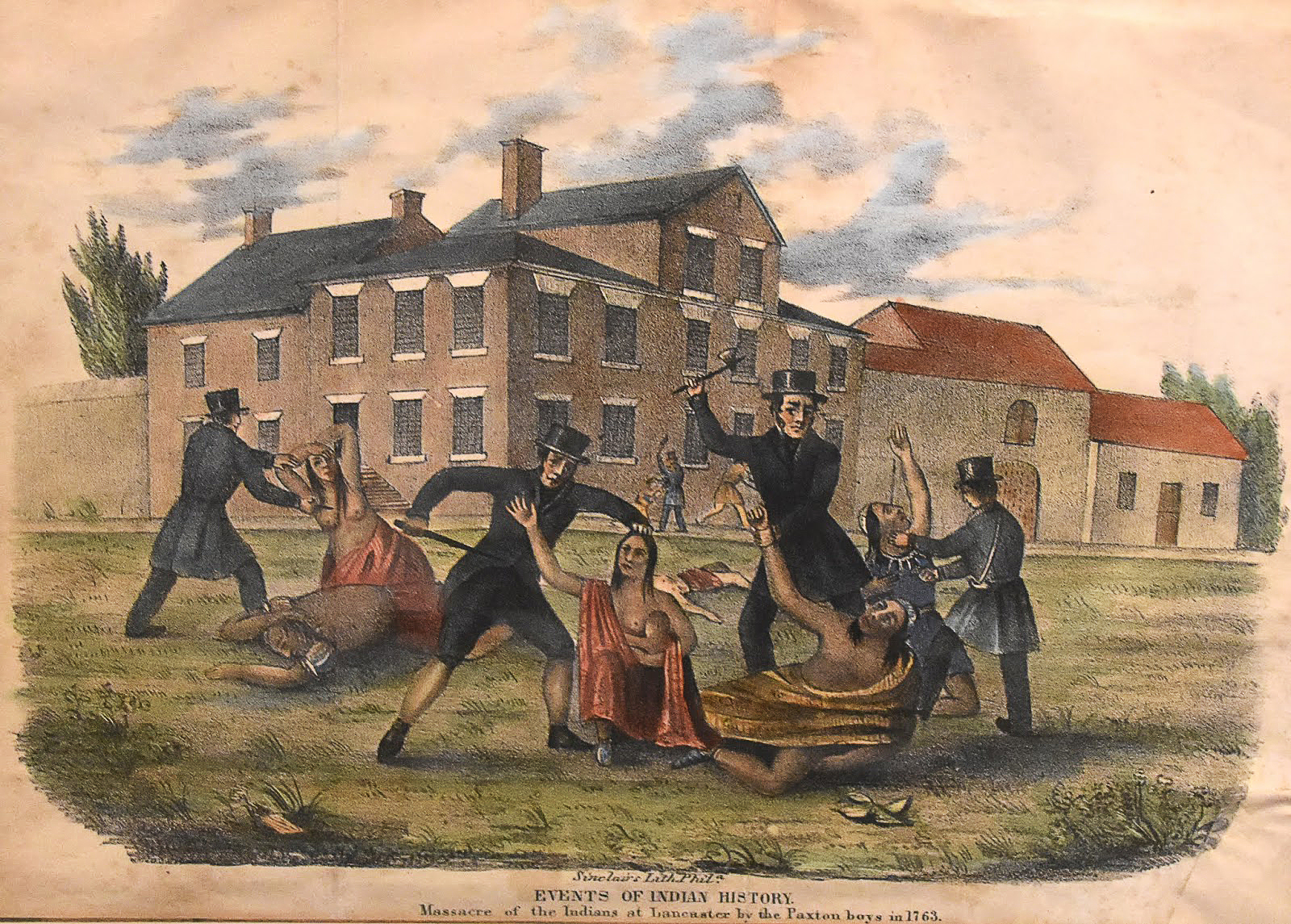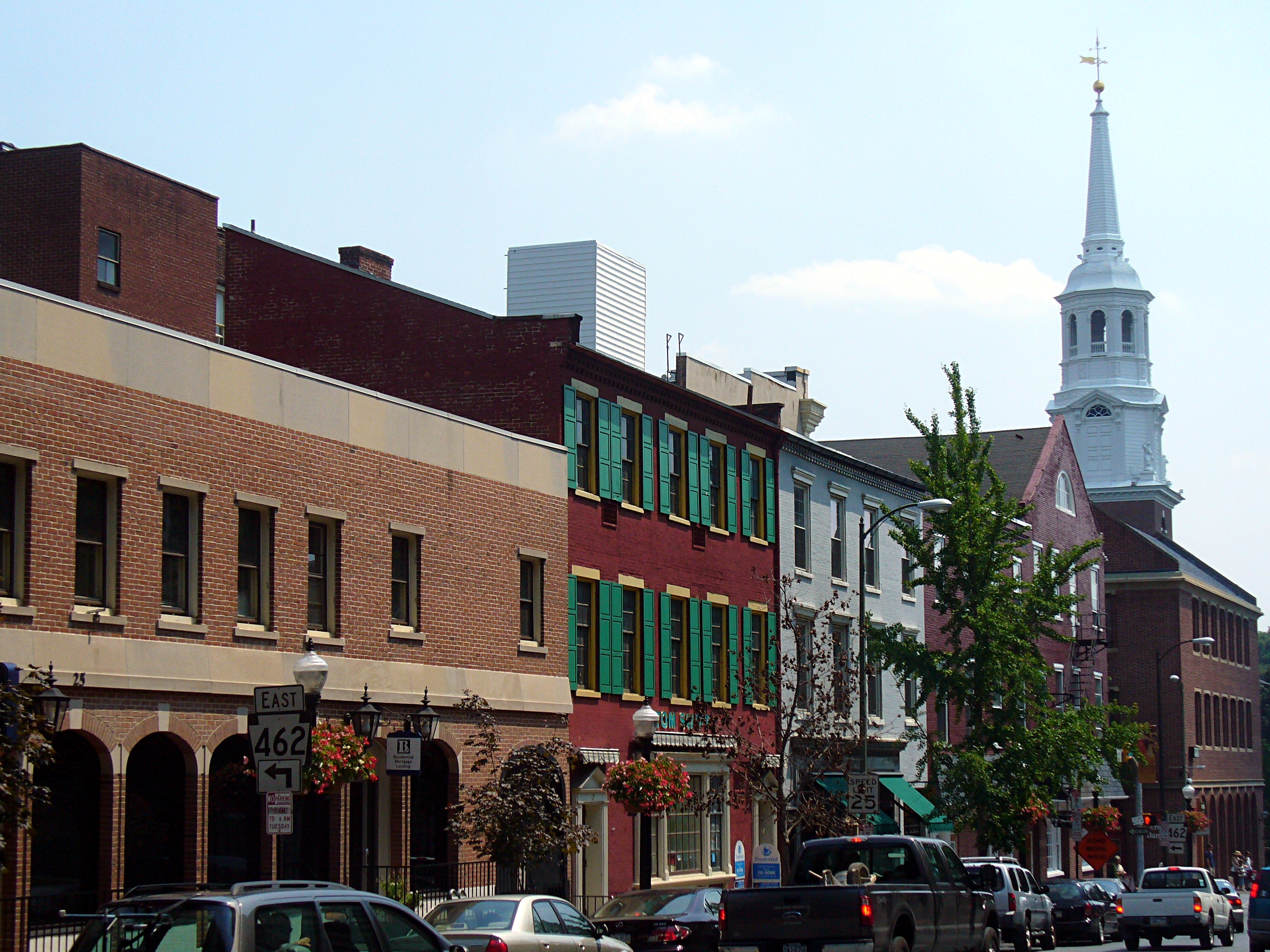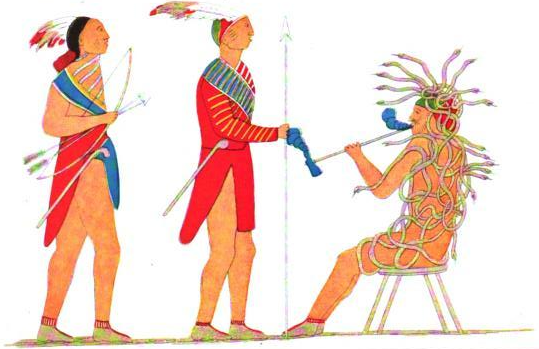|
Paxton Boys
The Paxton Boys were Pennsylvania's most aggressive colonists according to historian Kevin Kenny. While not many specifics are known about the individuals in the group their overall profile is clear. Paxton Boys Lived in hill country northwest of Lancaster County and across the Susquehanna River in Cumberland County. Due to their westward position, they were considered the frontier at the time and consistently targeted during Indian wars and conflicts. Due to the lack of support from the local Provincial Government, The Paxton boys formed a vigilante group in 1763 to defend themselves during the French and Indian War and Pontiac's War. Using their Presbyterianism faith, Paxton Boy's leadership declared that Native Americans were “Cainites”(A biblical representation of evil) and believed that they needed to be destroyed. The Paxton Boys did not limit their hate to Native Tribes but also “Whites, Quakers, and German Moravians, when they believed that these groups too jeopardize ... [...More Info...] [...Related Items...] OR: [Wikipedia] [Google] [Baidu] |
Paxton Massacre
Paxton may refer to: People and fictional characters * Paxton (name), a list of people and fictional characters with either the surname or given name Places Australia * Paxton, New South Wales United Kingdom * Paxton, Scottish Borders United States * Paxton, California * Paxton, Florida * Paxton, Illinois * Paxton, Indiana * Paxton, Massachusetts * Paxton, Nebraska * Paxton, West Virginia * Paxton Township, Minnesota * Paxton Township, Ross County, Ohio * Paxton Creek, a tributary of the Susquehanna River in Pennsylvania Businesses * Paxton Automotive, an American manufacturer of automotive superchargers * Paxton Hotel, formerly Paxton Manor and currently The Paxton, in Downtown Omaha, Nebraska, U.S. * Paxton Media Group, an American media company Other uses * ''Paxton'' (fish), a genus of fish from the family ''Apogonidae'' * Paxton (soil), the state soil of Massachusetts See also * Great Paxton, England * Little Paxton, England * Paxton House, Berwickshire, Scotland * ... [...More Info...] [...Related Items...] OR: [Wikipedia] [Google] [Baidu] |
Lancaster, Pennsylvania
Lancaster, ( ; pdc, Lengeschder) is a city in and the county seat of Lancaster County, Pennsylvania. It is one of the oldest inland cities in the United States. With a population at the 2020 census of 58,039, it ranks 11th in population among Pennsylvania's municipalities. The Lancaster metropolitan area population is 507,766, making it the 104th-largest metropolitan area in the U.S. and second-largest in the South Central Pennsylvania area. The city's primary industries include healthcare, tourism, public administration, manufacturing, and both professional and semi-professional services. Lancaster is a hub of Pennsylvania's Dutch Country. Lancaster is located southwest of Allentown and west of Philadelphia. History Originally called Hickory Town, the city was renamed after the English city of Lancaster by native John Wright. Its symbol, the red rose, is from the House of Lancaster. Lancaster was part of the 1681 Penn's Woods Charter of William Penn, and was laid ... [...More Info...] [...Related Items...] OR: [Wikipedia] [Google] [Baidu] |
The Light In The Forest
''The Light in the Forest'' is a novel first published in 1953 by U.S. author Conrad Richter. Though it is a work of fiction and primarily features fictional characters, the novel incorporates historic figures and is based in historical fact related to the late eighteenth century and period of the American Revolutionary War. A 1958 feature film of the same name was adapted from the novel and produced by Walt Disney Productions. It starred Fess Parker, Joanne Dru, James MacArthur, and Wendell Corey; Lawrence Edward Watkin, Paul J. Smith, and Hazel ("Gil") George composed the title song. Synopsis ''The Light in the Forest'' is about the struggles of a white boy, John Butler, who was taken captive as a boy in Pennsylvania by the Lenni Lenape Indians and became assimilated. The story opens in the autumn of 1764. John Butler, approximately fifteen years of age, has lived with the Lenni Lenape in Ohio since being taken captive eleven years earlier. His adoptive Lenape father, Cuy ... [...More Info...] [...Related Items...] OR: [Wikipedia] [Google] [Baidu] |
Six Nations Of The Iroquois
The Iroquois ( or ), officially the Haudenosaunee ( meaning "people of the longhouse"), are an Iroquoian Peoples, Iroquoian-speaking Confederation#Indigenous confederations in North America, confederacy of First Nations in Canada, First Nations peoples in northeast North America/Turtle Island (Native American folklore), Turtle Island. They were known during the Colonial history of the United States, colonial years to the French as the Iroquois League, and later as the Iroquois Confederacy. The English people, English called them the Five Nations, comprising the Mohawk people, Mohawk, Oneida people, Oneida, Onondaga people, Onondaga, Cayuga people, Cayuga, and Seneca people, Seneca (listed geographically from east to west). After 1722, the Iroquoian-speaking Tuscarora people from the southeast were accepted into the confederacy, which became known as the Six Nations. The Confederacy came about as a result of the Great Law of Peace, said to have been composed by The Great Peacem ... [...More Info...] [...Related Items...] OR: [Wikipedia] [Google] [Baidu] |
Sullivan Expedition
The 1779 Sullivan Expedition (also known as the Sullivan-Clinton Expedition, the Sullivan Campaign, and the Sullivan-Clinton Genocide) was a United States military campaign during the American Revolutionary War, lasting from June to October 1779, against Loyalists and the four British allied Nations of the Iroquois (also known as the Haudenosaunee). The campaign was ordered by George Washington, in response to the 1778 Iroquois–British attacks on Wyoming, German Flatts and Cherry Valley, with the aim of "taking the war home to the enemy to break their morale". The Continental Army carried out a scorched-earth campaign, chiefly in the lands of the Iroquois Confederacy (also known as the Longhouse Confederacy) in what is now Pennsylvania and western New York state. The expedition was largely successful, with more than 40 Iroquois villages and their stores of winter crops destroyed, breaking the power of the Iroquois in New York all the way to the Great Lakes.Ordering the "parti ... [...More Info...] [...Related Items...] OR: [Wikipedia] [Google] [Baidu] |
North Branch Susquehanna River
The Susquehanna River (; Lenape: Siskëwahane) is a major river located in the Mid-Atlantic region of the United States, overlapping between the lower Northeast and the Upland South. At long, it is the longest river on the East Coast of the United States. By watershed area, it is the 16th-largest river in the United States,Susquehanna River Trail , accessed March 25, 2010.Susquehanna River , Green Works Radio, accessed March 25, 2010. ... [...More Info...] [...Related Items...] OR: [Wikipedia] [Google] [Baidu] |
Joseph Brant
Thayendanegea or Joseph Brant (March 1743 – November 24, 1807) was a Mohawk people, Mohawk military and political leader, based in present-day New York (state), New York, who was closely associated with Kingdom of Great Britain, Great Britain during and after the American Revolution. Perhaps the Native Americans in the United States, Native American of his generation best known to the Americans and British, he met many of the most significant Anglo-American people of the age, including both George Washington and George III of the United Kingdom, King George III. While not born into a hereditary leadership role within the Iroquois, Iroquois League, Brant rose to prominence due to his education, abilities, and connections to British officials. His sister, Molly Brant, was the wife of Sir William Johnson, 1st Baronet, Sir William Johnson, the influential British Superintendent of Indian Affairs in the province of New York. During the American Revolutionary War, Brant led Mo ... [...More Info...] [...Related Items...] OR: [Wikipedia] [Google] [Baidu] |
Mohawk People
The Mohawk people ( moh, Kanienʼkehá꞉ka) are the most easterly section of the Haudenosaunee, or Iroquois Confederacy. They are an Iroquoian-speaking Indigenous people of North America, with communities in southeastern Canada and northern New York State, primarily around Lake Ontario and the St. Lawrence River. As one of the five original members of the Iroquois League, the Kanienʼkehá꞉ka are known as the Keepers of the Eastern Door – the traditional guardians of the Iroquois Confederation against invasions from the east. Historically, the Kanienʼkehá꞉ka people were originally based in the valley of the Mohawk River in present-day upstate New York, west of the Hudson River. Their territory ranged north to the St. Lawrence River, southern Quebec and eastern Ontario; south to greater New Jersey and into Pennsylvania; eastward to the Green Mountains of Vermont; and westward to the border with the Iroquoian Oneida Nation's traditional homeland territory. Kanienʼkehá ... [...More Info...] [...Related Items...] OR: [Wikipedia] [Google] [Baidu] |
Wyoming Valley
The Wyoming Valley is a historic industrialized region of Northeastern Pennsylvania. The region is historically notable for its influence in helping fuel the American Industrial Revolution with its many anthracite coal-mines. As a metropolitan area, it is known as the Scranton/Wilkes-Barre metropolitan area, after its principal cities, Scranton and Wilkes-Barre. With a population of 567,559 as of the 2020 United States census, it is the fifth-largest metropolitan area in Pennsylvania, after the Delaware Valley, Greater Pittsburgh, the Lehigh Valley, and the Harrisburg–Carlisle metropolitan statistical areas. Within the geology of Pennsylvania the Wyoming Valley makes up its own unique physiographic province, the Anthracite Valley. Greater Pittston occupies the center of the valley. Scranton is the most populated city in the metropolitan area with a population of 77,114. The city of Scranton grew in population after the 2015 mid-term census while Wilkes-Barre declined in po ... [...More Info...] [...Related Items...] OR: [Wikipedia] [Google] [Baidu] |
American Revolutionary War
The American Revolutionary War (April 19, 1775 – September 3, 1783), also known as the Revolutionary War or American War of Independence, was a major war of the American Revolution. Widely considered as the war that secured the independence of the United States, fighting began on April 19, 1775, followed by the Lee Resolution on July 2, 1776, and the Declaration of Independence on July 4, 1776. The American Patriots were supported by the Kingdom of France and, to a lesser extent, the Dutch Republic and the Spanish Empire, in a conflict taking place in North America, the Caribbean, and the Atlantic Ocean. Established by royal charter in the 17th and 18th centuries, the American colonies were largely autonomous in domestic affairs and commercially prosperous, trading with Britain and its Caribbean colonies, as well as other European powers via their Caribbean entrepôts. After British victory over the French in the Seven Years' War in 1763, tensions between the motherland and he ... [...More Info...] [...Related Items...] OR: [Wikipedia] [Google] [Baidu] |
Wyoming Massacre
The Battle of Wyoming, also known as the Wyoming Massacre, was a military engagement during the American Revolutionary War between Patriot militiamen and a mixed force of Loyalist soldiers and Iroquois raiders. The clash took place in the Wyoming Valley of Pennsylvania on July 3, 1778, in Exeter and Wyoming, Pennsylvania. More than 300 Patriots were killed in the battle. After the battle, Patriot settlers claimed that the Iroquois raiders had hunted and killed fleeing Patriots, and had then ritually tortured 30 to 40 who had surrendered until they died. In the massacre that followed, which was committed entirely by the Iroquois raiders, 360 American men, women, and children died, and many who escaped to the forests subsequently expired of starvation or exposure. Background In 1777, British general John Burgoyne led the Saratoga campaign to gain control of the Hudson River during the American Revolutionary War. He was weakened by loss of time and men after the Battle of Oriska ... [...More Info...] [...Related Items...] OR: [Wikipedia] [Google] [Baidu] |
Iroquois
The Iroquois ( or ), officially the Haudenosaunee ( meaning "people of the longhouse"), are an Iroquoian-speaking confederacy of First Nations peoples in northeast North America/ Turtle Island. They were known during the colonial years to the French as the Iroquois League, and later as the Iroquois Confederacy. The English called them the Five Nations, comprising the Mohawk, Oneida, Onondaga, Cayuga, and Seneca (listed geographically from east to west). After 1722, the Iroquoian-speaking Tuscarora people from the southeast were accepted into the confederacy, which became known as the Six Nations. The Confederacy came about as a result of the Great Law of Peace, said to have been composed by Deganawidah the Great Peacemaker, Hiawatha, and Jigonsaseh the Mother of Nations. For nearly 200 years, the Six Nations/Haudenosaunee Confederacy were a powerful factor in North American colonial policy, with some scholars arguing for the concept of the Middle Ground, in that Europe ... [...More Info...] [...Related Items...] OR: [Wikipedia] [Google] [Baidu] |










